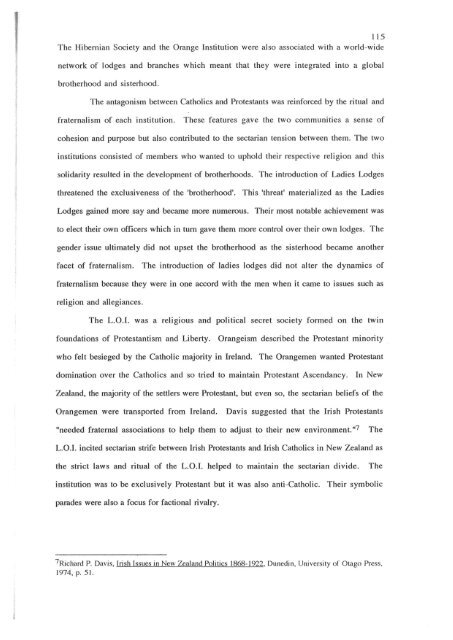TRANSPLANTED IRISH INSTITUTIONS - University of Canterbury
TRANSPLANTED IRISH INSTITUTIONS - University of Canterbury
TRANSPLANTED IRISH INSTITUTIONS - University of Canterbury
Create successful ePaper yourself
Turn your PDF publications into a flip-book with our unique Google optimized e-Paper software.
115<br />
The Hibernian Society and the Orange Institution were also associated with a world-wide<br />
network <strong>of</strong> lodges and branches which meant that they were integrated into a global<br />
brotherhood and sisterhood.<br />
The antagonism between Catholics and Protestants was reinforced by the ritual and<br />
fraternalism <strong>of</strong> each institution.<br />
These features gave the two communities a sense <strong>of</strong><br />
cohesion and purpose but also contributed to the sectarian tension between them. The two<br />
institutions consisted <strong>of</strong> members who wanted to uphold their respective religion and this<br />
solidarity resulted in the development <strong>of</strong> brotherhoods. The introduction <strong>of</strong> Ladies Lodges<br />
threatened the exclusiveness <strong>of</strong> the 'brotherhood'. This 'threat' materialized as the Ladies<br />
Lodges gained more say and became more numerous. Their most notable achievement was<br />
to elect their own <strong>of</strong>ficers which in tum gave them more control over their own lodges. The<br />
gender issue ultimately did not upset the brotherhood as the sisterhood became another<br />
facet <strong>of</strong> fraternalism.<br />
The introduction <strong>of</strong> ladies lodges did not alter the dynamics <strong>of</strong><br />
fraternalism because they were in one accord with the men when it came to issues such as<br />
religion and allegiances.<br />
The L.O.I. was a religious and political secret society formed on the twin<br />
foundations <strong>of</strong> Protestantism and Liberty. Orangeism described the Protestant minority<br />
who felt besieged by the Catholic majority in Ireland. The Orangemen wanted Protestant<br />
domination over the Catholics and so tried to maintain Protestant Ascendancy. In New<br />
Zealand, the majority <strong>of</strong> the settlers were Protestant, but even so, the sectarian beliefs <strong>of</strong> the<br />
Orangemen were transported from Ireland.<br />
Davis suggested that the Irish Protestants<br />
"needed fraternal associations to help them to adjust to their new environment."7<br />
The<br />
L.O.I. incited sectarian strife between Irish Protestants and Irish Catholics in New Zealand as<br />
the strict laws and ritual <strong>of</strong> the L.O.I. helped to maintain the sectarian divide.<br />
The<br />
institution was to be exclusively Protestant but it was also anti-Catholic. Their symbolic<br />
parades were also a focus for factional rivalry.<br />
7Richard P. Davis, Irish Issues in New Zealand Politics 1868-1922, Dunedin, <strong>University</strong> <strong>of</strong> Otago Press,<br />
1974, p. 51.
















